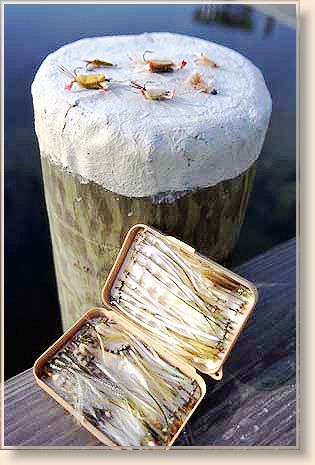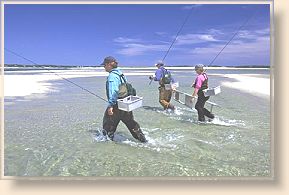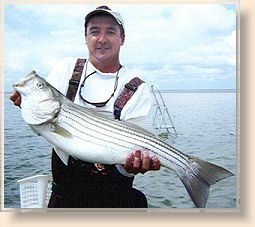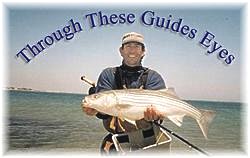Fishing tactics and techniques must change at this
time of the year. Care to learn?
 The now "educated" finny residents have all graduated from high school and
are now on their way to receiving their bachelor's degree on what is edible or
not. These are our FUSSY fish! To me this is the most challenging and fun time
of the year. We're seeing on the average of one to two hundred fish on the flats
in a day under the right conditions. Thirty percent of them are big - ten to twenty
pounds. Talk about mastering your technique of sight fishing on the sand flats.
There's no such thing as an easy fish. All the pieces of the puzzle must come
completely together to succeed on the flats. Longer leaders (12 foot tapered 8 to
10 pounds), Fluorocarbon leaders, smaller flies. Leading fish by thirty to seventy-five
feet. Knowing your water to determine exactly when in the tide they will show up on
certain flats. Knowing structure, so the fish will be funneled by you, allowing
you the most "shots." Believe it or not, we're catching lots of the big ones on bonefish
flies. We're just showing them something different and helping with their education.
Slowing down your retrieve and sometimes dead drifting the fly to a big sighted fish
works. Most of the time no retrieve at all using crabs is best and setting by sight is
the answer. Achieving speed and accuracy in your casting skills is a must.
The now "educated" finny residents have all graduated from high school and
are now on their way to receiving their bachelor's degree on what is edible or
not. These are our FUSSY fish! To me this is the most challenging and fun time
of the year. We're seeing on the average of one to two hundred fish on the flats
in a day under the right conditions. Thirty percent of them are big - ten to twenty
pounds. Talk about mastering your technique of sight fishing on the sand flats.
There's no such thing as an easy fish. All the pieces of the puzzle must come
completely together to succeed on the flats. Longer leaders (12 foot tapered 8 to
10 pounds), Fluorocarbon leaders, smaller flies. Leading fish by thirty to seventy-five
feet. Knowing your water to determine exactly when in the tide they will show up on
certain flats. Knowing structure, so the fish will be funneled by you, allowing
you the most "shots." Believe it or not, we're catching lots of the big ones on bonefish
flies. We're just showing them something different and helping with their education.
Slowing down your retrieve and sometimes dead drifting the fly to a big sighted fish
works. Most of the time no retrieve at all using crabs is best and setting by sight is
the answer. Achieving speed and accuracy in your casting skills is a must.
July 7- 8 Report
 From the second we waded onto the flats in the early morning until we pulled
ourselves away in the late afternoon, we were sighting large numbers of ten to
twenty pound bass in one to three feet of water! Did we slay'em? I wish! Did we
have the time of our lives trying to outsmart them? You betcha! All fish caught
were done so on either the dropping or incoming tide. We cast to several big ones
during slack tide but none were too eager to eat. They were only eating 1 ½ inch
sand lances and 1 ½ inch shrimp.
From the second we waded onto the flats in the early morning until we pulled
ourselves away in the late afternoon, we were sighting large numbers of ten to
twenty pound bass in one to three feet of water! Did we slay'em? I wish! Did we
have the time of our lives trying to outsmart them? You betcha! All fish caught
were done so on either the dropping or incoming tide. We cast to several big ones
during slack tide but none were too eager to eat. They were only eating 1 ½ inch
sand lances and 1 ½ inch shrimp.
Aug. 8-Report
Perfect day for sight fishing. I walked, walked and walked and saw fish, fish, fish.
More than I have seen in a while (400-Aprox.) Came to one creek and counted no
less than 100, just hanging around feeding in 3ft. water. Caught some, but got bored,
no challenge, moved on. The most productive fly for me has been Toms rattle crab!
Walked a short distance to where the creek empties into a tidal river and found 75
or so hanging around the drop-off. Decided to only present to the biggest bass
and could not fool them, so moved on leaving them undisturbed and less educated,
if there is such a thing this time of year. Normally you'll see 100-200 in a day if conditions
are right and you know where they feed, travel at different stages of the tide. Monomoy
is a huge vast area, which requires a lot of time on the water (T.O.W.) to fish it proficiently,
in my opinion. Knowing structure and currents will help you figure out the routes they
travel day after day and take the guess work out of it. Knowing the dominant bait and
imitating it exactly will put you in the ballpark (silver sides and sand lances-1-3 in. long,
half the thickness of a pencil.) Use clear intermediate lines, long leaders and you're rigged
for most sight fishing situations this time of year.
More Tips:
 Try holding ten to fifteen feet of fly line outside the tip when sight casting to allow fewer
false casts. Don't blind cast. If you can't see them, they are not there. The commotion
generated from blind casting will surely spook any fish just out of sight that you may
have had a shot at. Or what usually happens to me after I've made that eighty-foot cast,
a nice bass comes by within twenty feet and swims under my line. Ha!
Try holding ten to fifteen feet of fly line outside the tip when sight casting to allow fewer
false casts. Don't blind cast. If you can't see them, they are not there. The commotion
generated from blind casting will surely spook any fish just out of sight that you may
have had a shot at. Or what usually happens to me after I've made that eighty-foot cast,
a nice bass comes by within twenty feet and swims under my line. Ha!
Lead the fish by forty to fifty feet. Before casting, decide its projected path. Current direction,
depth of water and contour of bottom are the keys to success in this determination. By
leading the fish so far in advance you are allowing your fly to sink to eye level of the fish
and tripling your chance of success. Hoping the fish will rise up to your fly is normally
met with a refusal, unless you are lucky enough to be on a hot fish. Anytime you can
make it easier for the fish to feed, so fish has to exert as little energy as possible, you'll
triple your catch rate. Ever thought about using a 300 to 400 grain ORVIS depth-charge
fly line in two to six feet of water to achieve this? I've been doing it for years (Thanks,
Bob) and it's produced some real COWS!
Temperature of water is key. In the spring and early summer search out warmer water,
you'll be rewarded with fish. In mid to late summer do the opposite. Hope this will help
you the next time you visit my home away from home.
Next Time, Baitology! ~ Randy Jones
About Randy:

Randy Jones is a full-time professional fly/spin fishing guide with over
18 years of experience. He has represented the Orvis Corporation as a
guide and chief instructor of their 2 1/2 day Saltwater Fly fishing
schools. During the summer, Randy can be found guiding the Monomoy Island area
where sight casting on the flats to trophy Striped Bass is his
specialty. During the Fall, Winter, and Spring Randy runs drift boat and
wade trips on the world class Salmon River for Steelhead, Coho, Browns,
Atlantics, and Kings.
E-mail randysjones@earthlink.net
or visit his Web Site: https://www.yankeeangler.com/
|

